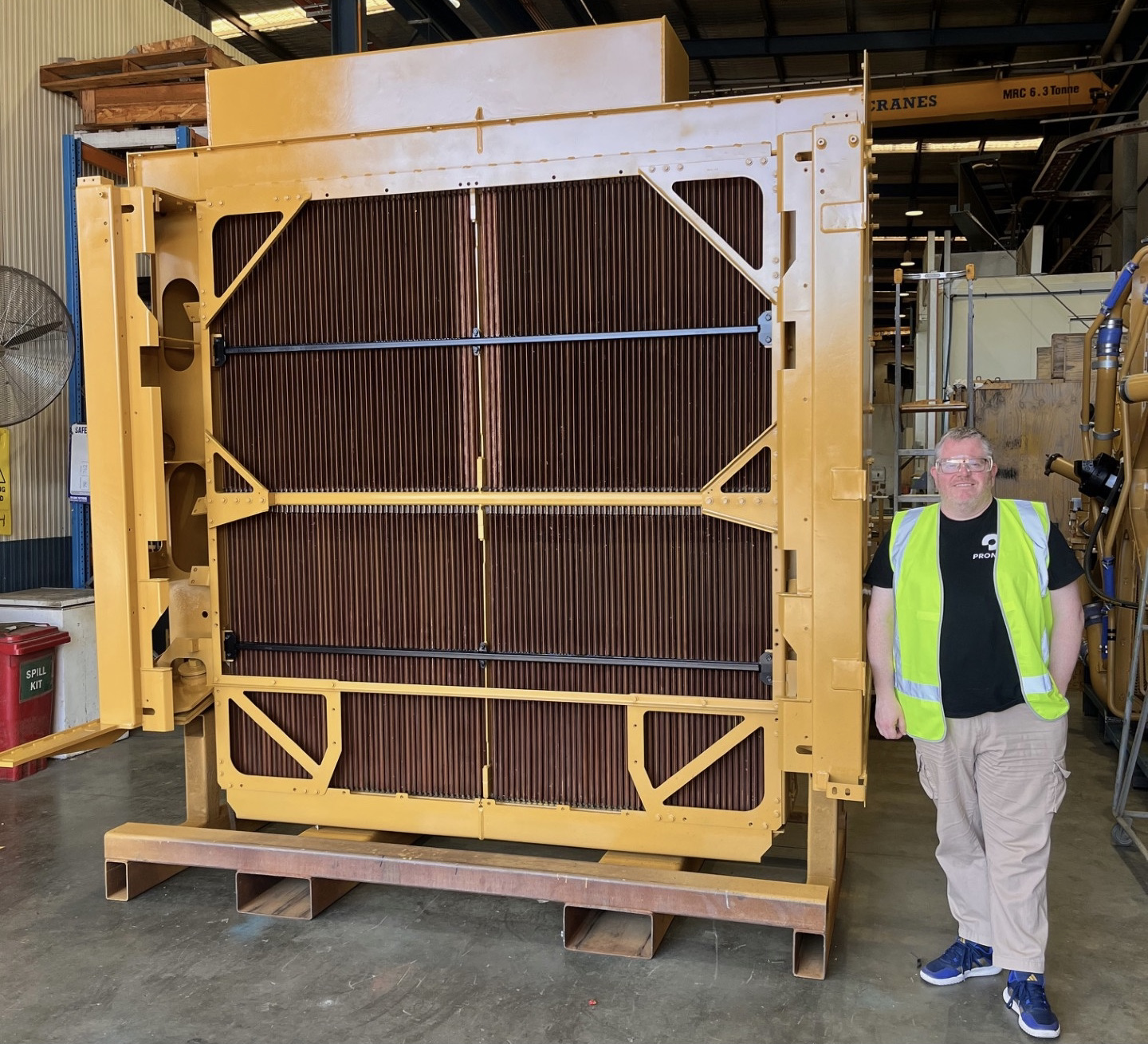IM Editorial Director Paul Moore recently spent time with L&M Radiator, a Wabtec company, the firm behind the global premium mining radiator brand MESABI®, to discuss its market leadership and technology focus.
L&M Radiator’s MESABI® brand is the world leader in copper grommeted tube radiators for mining, especially in large mining haul trucks but also a range of other mining machinery, including hydraulic mining excavators and surface drills, as well as a wide range of underground equipment. Its market position has been built up via its tried and trusted and often customised heat exchanger solutions for mining customers, that has allowed it to build up a unique loyalty thanks to their proven longevity and reliability.
L&M Radiator Pty Ltd Sales Manager Tony Coppins (left) and General Manager Richard Chapell (right)
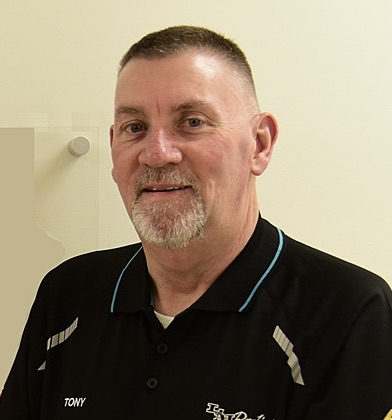
IM recently talked to the company first hand in both Western Australia and Chile. In Western Australia, L&M Radiator Pty Ltd’s facility is located in Welshpool, Perth, where Richard Chapell, General Manager and Tony Coppins, Sales Manager, discussed the market in some depth. The business based there and throughout Australia is divided 80% aftermarket and 20% OEM. The major OEM handled directly from Australia is Epiroc – for whom Perth handles MESABI® radiator supply in Australia but also Sweden, China and India. This includes underground trucks and LHDs. L&M Radiator does have a major OEM business worldwide, but it tallies with where the customer is based – for example for mining trucks, Komatsu, Caterpillar and Liebherr both manufacture in the US, so are supplied via L&M Radiator’s HQ in Hibbing, Minnesota and its Yankton, South Dakota facility.
Aftermarket wise in Australia, L&M Radiator does service work for all the big mining truck brands – Caterpillar, Komatsu, Liebherr, Hitachi as well as Epiroc and Sandvik underground equipment – and it works directly with all the big mining houses – including BHP, Rio Tinto, Roy Hill and Fortescue in the Pilbara as well as CITIC Pacific.
Chapell told IM: “The customer may or may not specify MESABI® when these machines are first built – but in general it is first fit anyway in most cases, including most Caterpillar and Komatsu trucks including from the 793 to 798 and the 730E to 980E. This accounts for the majority of the mining market. These genuine MESABI® radiators are supplied from L&M Mesabi facilities n the US in Hibbing, Minnesota or Yankton, South Dakota and fitted at the OEM locations in Peoria. Then MESABI® in Australia services these products once they are in operation in Australia. These trucks are typically completely rebuilt every three or four years and we at MESABI® offer a fully certified rebuild of the radiator. For Western Australia we do that ourselves 100% in Perth.”
Working with L&M Radiator means customers have the reassurance of getting a quality certified MESABI® rebuild including the quality parts
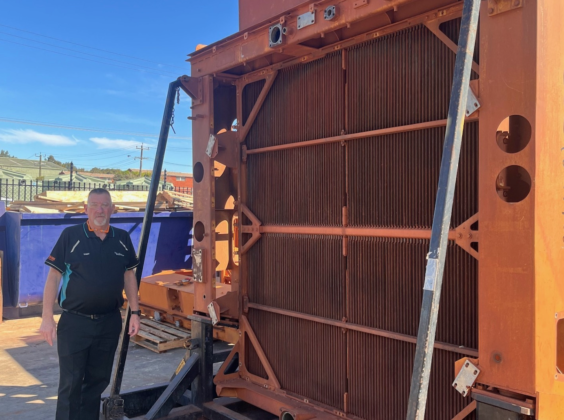
He adds: “Working with us means they have the reassurance of getting a quality certified rebuild including the quality parts. In India, Mongolia, Indonesia, and the Australian East Coast, L&M Radiator works via a network of recognised MESABI® service centres that carry out the same work to the same standard such as PT Bhumi Phala Perkasa in Balikpapan. The same applies in many other major mining markets such as North and South America. Beyond these service centres, the company also works with other radiator shops, supplying full training and parts to ensure they achieve the same results. All of these locations are also regularly audited.”
In addition, if for whatever reason the truck being supplied in Australia is not being supplied in full by the OEM, or the radiator needs replacing, the Perth facility also supplies and fits new radiators or whatever major components need replacing.
Coppins said on the company’s strength: “The market position for MESABI® in Australia has been driven by the miners wanting our product on their fleets and actively specifying it. And that is for a good reason – including serviceability, longevity, quality and reliability. The fact that these miners specify Mesabi – which is a premium product – means OEMs and dealers are less likely to look at cheaper and lower performance solutions over time.”
What is the MESABI® difference?
What are the MESABI® differentiators? Coppins: “Probably the most significant is that MESABI® radiators are a field repairable product – that means everything down to individual tubes. With a MESABI®, you can simply plug the top and bottom seals and keep on working, until you can get the equipment back into the shop for maintenance. Because the copper tubes are individually replaceable, those damaged tubes even can be removed and replaced right on the site of any incident like a collision. While replacement times vary, it takes many operations less than one hour to replace a few tubes. This is compared to a damaged tube on a non-MESABI® radiator, which could cause operations to cease for an indefinite amount of time.”
MESABI® radiators are a field repairable product – that means everything down to individual tubes
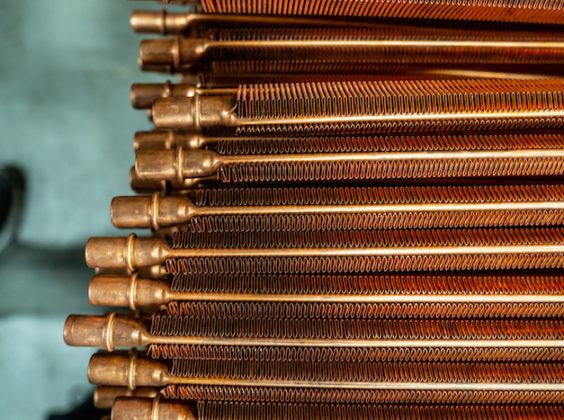
Chapell explained that MESABI® radiators can be brought back to near 100% cooling capacity over and over again, whereas with all other mining equipment scale products you have to replace the whole radiator. “MESABI® specifically offers a heavy duty radiator with copper cores for the mining industry, which is suspended in a rubber seal, so the core cooling product does not deteriorate through cracking and leaking causing failures. Cheaper radiators tend to use all fabricated aluminium with no rubber support so are for the most part, unrepairable and must be replaced wholesale. And it is the downtime that results that really hurts the mining companies just as much as the replacement cost itself.”
A long and guaranteed lifetime
What is the life cycle of a typical MESABI® radiator then from new mining truck to end of life? Chapell: “Take a Komatsu 930E – it will have been shipped from Peoria to Australia with a new MESABI® radiator – the engine module on these trucks, which includes the radiator, all on the engine frame, typically lasts about 30,000 hours in the Pilbara which is around four years. That comes out and a new module is put in so the truck can keep working. The used module gets transported to Perth where the engine and alternator and radiator get taken off. The radiator comes to L&M Radiator’s facility for repair, the engine goes to Cummins and the alternator goes to Wabtec.”
He adds: “The radiator is fully stripped and repaired, including repairing any defects in the steelwork to the OEM’s latest specifications. The radiator itself is overhauled by fitting all new rubber seals, but only the MESABI® copper, aluminium or brass tubes that need replacing get replaced. But all the tubes are removed and cleaned internally and externally. The frame is painted, the radiator tested, and then it goes back into the market with a 36 month warranty against seal leakage. The MESABI® radiators go into use for the life of the engine – as it makes sense to coordinate with the engine life in this way. But engines have not always lasted 30,000 hours – 20 years ago it was more like 20,000 hours. This is thanks first to engine improvements such as to Tier 4 Final versions, but also it is about improvements in servicing by mechanics and much more use of sensors and analysis with predictive maintenance – such as using oil analysis to show up any bearing material – if something shows up the engine is taken out. At 20,000 hours the MESABI® radiator was actually coming out too early and in most cases had not reached the end of the warranty. Today it is more of a sweet spot aligned with the new engine life capabilities.”
So how many of these 30,000 hour rebuilds will typically be done on a truck? Coppins: “In fact, if you take the 930E, not that many have been scrapped in Australia. They don’t just rebuild the radiator and engine – they also rebuild the truck itself at regular intervals. There are quite a number up around 100,000 hours or more of operation. In the past, a decade of operation and three rebuilds was seen as the norm – today we are looking at more like four or five rebuilds.”
Today the technology exists to take a whole truck chassis apart and remove fatigued parts, including grinding down fatigued welds and replacing with new high precision welding. So the chassis itself can be reborn, something that was not done previously. The combination of new technology and new thinking. It’s also about major components having had an OEM life expectancy which have been far surpassed safely and successfully using the latest analysis and predictive maintenance technologies.
Solutions for the low emissions generation
The mining truck world is slowly seeing some moves towards new technologies focused on decarbonisation. Chapell: “At L&M Radiator we are working with many of the major mining houses and new mining truck technology players on how we can help them on this journey. The first stage of that is working with hybrid diesel-battery trucks and eventually we will likely see full battery trucks. With the hybrid system we are, in conjunction with the engine manufacturers, providing solutions for the different cooling needs of these new systems. For hybrid trucks and smaller battery packs where the truck uses regenerative braking we think we can supply what the industry requires with our current technology that reduce temperatures to ambient conditions – but going forward as battery packs get larger and require fast charging solutions, they will need refrigerant type cooling or use of special cooling fluids, both of which we are also working on.”
The nuGen FCEV mining truck, a converted Komatsu 930E, was equipped with a specially designed MESABI® radiator
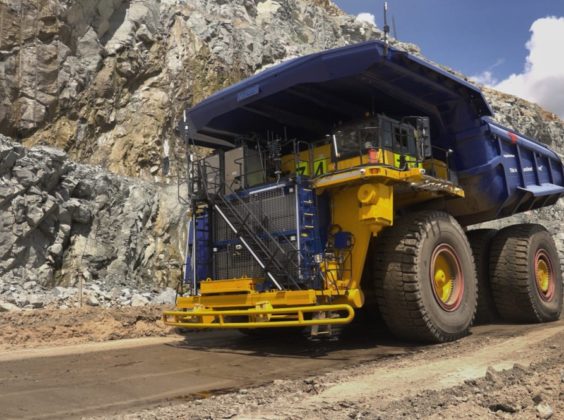
This is because it is not enough to cool these larger batteries to ambient – they need to be maintained at around 20°C whereas many mines in the Pilbara for example have an ambient temperature of 40-45°C. “We have designed our own refrigeration unit to work with our radiators, for example, to cool the battery packs but also the electronics associated with them.”
Coppins added that L&M Radiator already has experience with new generation, lower emissions trucks – the nuGen FCEV mining truck, a converted Komatsu 930E with a battery pack and hydrogen fuel cells, was successfully trialled at the Mogalakwena platinum mine in South Africa and was equipped with a specially designed MESABI® radiator. L&M Radiator engineered an all-aluminium M-tube cooler for fuel cell cooling compatibility with the existing coolant on the 930E as brass and copper were not viable options. Coppins: “The system also used an electric drive fan system – one of the first to ever be used on a large mining haul truck. Plus the radiator is much bigger to provide more cooling – all of this was needed as hydrogen fuel cells emit a lot of heat, especially towards the end of their operating life. The heat rejection increases as the powertrain ages. When you combine hydrogen and oxygen to make electricity, the exothermic reaction produces heat and electricity, which must be removed, otherwise, the fuel cell overheats.”
Chapell: “We have the capacity to meet the future needs of next generation decarbonised mining truck cooling systems. We are working with all the major players to make sure that they have the cooling requirement answers that they need for these new lower emissions or net zero mining truck designs. A lot of battery electric vehicles actually require more cooling than a diesel engine. With First Mode we worked with them to meet their needs for the package that was designed at the time.”
What about combustion engines running on biofuels, hydrogen or even methanol – what about their cooling needs? Chapell: “Generally if you are still running an engine, the engine specifications will be similar. We supply radiators to a lot of trucks that have had engine repowers to a slightly higher rating – and our radiator in some cases can do the job again without any alteration – so for these alternative combustion engines, we think our radiator will continue to be the answer to their needs whatever fuel you are putting through the engine. And if we do need to bolster the radiator and make some changes, as our design is so unique, we can easily make upgrades.”
Coppins and Chapell also said that the company has worked with a lot of Komatsu truck repowers from Cummins HPI to Cummins MCRS engines bringing more fuel efficiency, lower PM and longer life. Coppins: “In this case there was a cooling capacity increase requirement. Our radiators are split into two halves with a high temperature and low temperature circuit. The high temperature circuit was fine but the low temperature circuit had to go from two rows to three rows. So instead of designing a whole new radiator, we were able to make this change to the package, allowing the customer to reuse over 50% of the existing radiator – the customer was very happy as they are having to make a big change with an all new engine, but didn’t have to have an entirely new radiator. In other cases no changes are needed at all, in others more subtle changes like a new fan. So as stated with the new lower emissions trucks, there are opportunities for us to use the existing radiator design but with modifications and reconfigurations.” Aside from the trucks themselves, L&M is also creating cooling packages for the fast charging systems, as they create a lot of heat.
What of mining excavators?
Finally, a note on excavators and engine cooling. Coppins: “The majority of large hydraulic mining excavators have our cooling systems – including most Komatsu and Liebherr models. All these excavators have significant hydraulic systems which need cooling – and we do a lot of these in the aftermarket, but we are looking at increasing our presence in the OEM market as well. In terms of the market evolving to cable tethered machines – many of these will be tethered to banks of battery packs or even fuel cells and battery packs which need cooling – with these linked to renewable power sources like wind and solar. So, for many electric solutions, cooling will be needed both on the machine and off the machine. But at Mesabi® we are used to designing and customising cooling packages in mining to suit many different applications and so we will continue to do that as the market evolves.”
Being part of the Wabtec global network
What are the synergies of being part of the Wabtec family? Chapell: “First off, they have a very extensive global presence and infrastructure which will help to boost our MESABI® presence. For example, we have been looking at ways to support our mining customers in India more closely – and Wabtec is already there on the ground with facilities and locations. Also related to that we are working closely with the Indian mining truck OEM BEML for their trucks in the Indian market, so the Wabtec network helps us with that as well. Plus, Wabtec is very much a service driven company, so Mesabi® will likely be able to increase its own direct service network as well, for example in both North and South America.”
MESABI® might in Latin America
At the EXPONOR 2024 event in Antofagasta, Chile, IM also had the opportunity to talk to Mark Bausch, Sales Manager, L&M Industrial Radiator Sudamerica SpA.
L&M Radiator launched its own MESABI® radiator factory in Chile back in 2011 in Antofagasta. “We had been active in Chile through third parties, and additionally with a service partner, a Chilean company that has been servicing radiators for over 50 years, who we still work with. At our plant in Chile we produce our flagship copper tubes for MESABI® radiators – and this gives us a much greater ability to serve the local market fast – we can turn orders around in a day if we have to. We are flexible and we have all of the raw materials necessary. Similarly to the facility in Perth, in Antofagasta we are serving the aftermarket. That means responding to maintenance-based demand from the mines for an ultra-dependable radiator.”
IM Editorial Director, Paul Moore, with Mark Bausch, Sales Manager, L&M Industrial Radiator Sudamerica SpA, at Exponor 2024 in Antofagasta

He said this means maintaining existing MESABI® radiators during scheduled engine maintenance, but the facility also does a lot of conversions for customers from other brands to MESABI®. “The simple fact is most of the alternatives just do not last till the programmed engine maintenance intervals, whereas ours are able to follow them closely and in many cases go beyond them. Our mantra is two engine lives – after the first we of course inspect the radiator, but we won’t tear it down as there is no need. The customer already made the investment in uptime with our premium radiator, and so they will get those hours with no issues as our materials and our tolerances allow us to give that level of backing to our product.”
That said, the Chilean and Peruvian mines are a challenge – the majority operate above 3,000 m and some of them above 4,500 m with temperatures ranging from –20°C up to +35°C. The extreme altitude means the equipment requires far more horsepower than at sea level. Many trucks are fitted with high altitude kits to maintain performance but still they are pushing engines to their absolute limits as the operators still want to maximise tonnage. Bausch: “When using a non-MESABI® radiator/aftercooler combination, even a small aftercooler leak will generate a jet of air at super-heated temperature that is enough to deform the metal in these coolers. We have seen customers that have lost nine engines in this manner. Our solution is becoming the norm in Chile and Peru. New trucks arrive in South America with a MESABI® radiator already fitted. At the first engine rebuild or conventional non-MESABI® aftercooler failure, we will fit two robust MESABI® aftercoolers. Our equipment is designed and built to withstand that environment.”
As in Perth the Chile business is aftermarket – not OEM business – which is primarily carried out by L&M Radiator in the US. And similarly to Australia, in Chile L&M is mainly working with the mines directly and via service providers who can provide MESABI® integrated plug-and-play cooling modules, site services and programmed overhaul service at regional centres. “In Chile we have six MESABI® service centres operated by third party company Radiadores Gómez. In Peru, our service partner is International Wheel SAC. In Brazil, there are three service partners. Radiadores Nacional covers the northern Carajas region. Radiadores Liberio and Penachin Radiadores cover the south/southeast.”
MESABI® radiators are used on Komatsu and Liebherr trucks in Chile and Peru as well as most Caterpillar and Hitachi trucks, including the Cat 794, 797 and 798 fleets, plus L&M Radiator radiators offers MESABI® conversions for excavators including most of the Hitachi fleet in South America. Some of the large 797B mechanical drive trucks in Chile are now using a hybrid of the proven MESABI® BOSS® brass tube which is highly corrosion resistant and fits that application – yet another example of MESABI® case by case customisation.
Bausch similarly talked about the MESABI® difference: “Yes there are companies looking to compete with us and imitate our products. Their tubes don’t look or feel original and are not performing. When it comes time to overhaul an imitation, these radiators or at least most of the tubes within them, get scrapped. They might look similar at first glance, but they are unable to copy our material or our quality processes. Mines demand genuine MESABI® for good reason. They know they are going to get 30,000 hours plus out of every one of our radiators and that the tube replacement ratio at overhaul will be very low, especially if we have worked with them to meet their specific needs.”
On radiators for next generation trucks, L&M at EXPONOR 2024 displayed a smaller version of the radiator design it produced for Anglo American’s FCEV truck at Mogalakwena, to show the multiple systems involved including a standard radiator with coolant but also a super refrigeration unit that is under high pressure; then you have a heat exchanger which allows warm fluid to mix with super cooled fluid to manage the liquid temperature that is flowing through the rest of the system.
Bausch: “And this is relevant to batteries or fuel cells – in either case this allows us to keep the operating temperature within a very tight window. We also must consider the intense vibration that comes with operating in mining – that is where MESABI® flexible seal technology vastly outperforms welds – and is another area where we have unique experience and IP.”
The post The mining might of MESABI® appeared first on International Mining.

